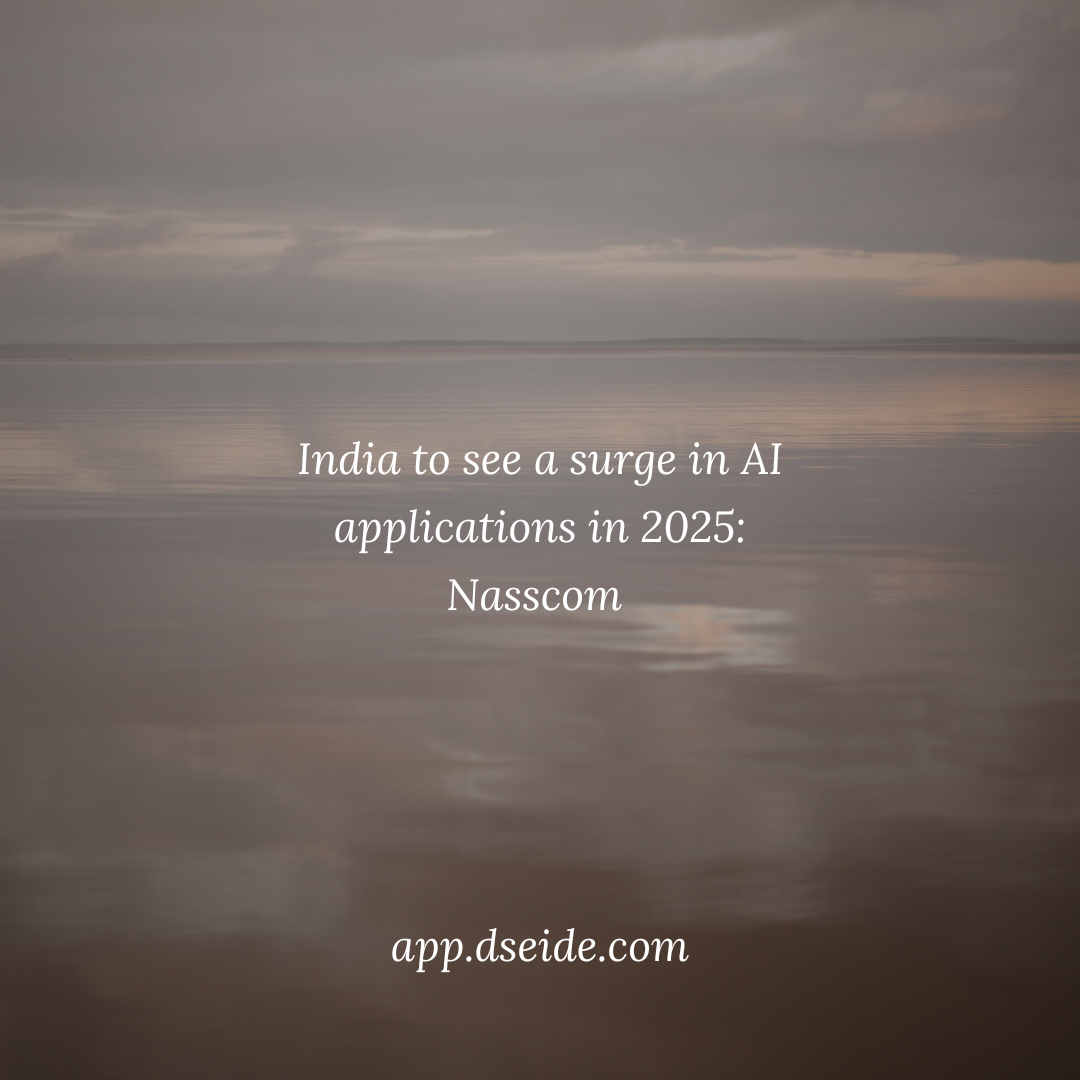India will see a rise in artificial intelligence (AI) applications and cost reductions in 2025, with increasing adoption across sectors like healthcare, finance, energy, and governance, Sanjeev Malhotra, CEO of the Centre of Excellence for IoT and AI at Nasscom, told FE.
“We will see more applications of AI across the board… most of the cost is computing and manpower, and as knowledge becomes more pervasive, more people get trained on this, I think the rate of application development will increase, so will the rate of adoption across the board,” he said.
He also said enterprises will derive more efficiencies and the fault rates will reduce. “I think the rest of the world will also start using more and more solutions from India,” he said.
The adoption of AI among Indian enterprises is progressing from proof-of-concept stages to full-scale production, particularly in the fintech and healthcare sectors, according to Malhotra.
Automated loan processing, fraud detection, and citizen grievance redressal are some of the leading use cases. “Governments are also beginning to use chatbots for grievance redressal, as it is not possible to deploy large numbers of call centre agents,” he said.
The availability of public LLMs from global tech giants is also fostering innovation among Indian startups. “When these [LLMs] are made public, it makes it easier for startups to use those products in creating applications,” Malhotra said. Startups are building domain-specific solutions by customising LLMs with additional features.
AI is also playing a growing role in critical areas like energy transition and healthcare. “In energy, applications optimise usage and extend battery life through software interventions. This has a cumulative impact, especially with the increasing adoption of electric vehicles,” he said. Malhotra also highlighted its use in predictive maintenance for power plants and grid optimisation.
Healthcare has seen similar progress, with chatbots providing initial diagnoses in multiple Indian languages. “Patients can talk to machines regarding their problems and receive good guidance…these chatbots now come in different languages, making them more open to adoption by the larger population,” Malhotra said.
To support startups and enterprises, the Nasscom Centre of Excellence has launched initiatives to accelerate AI adoption. Malhotra said co-creation between them helps enterprises discover existing solutions rather than building new ones from scratch, making it a “win-win” situation.
“This programme connects startups with industries and funding organisations, making it easier for startups to access large enterprises,” he said.
Nasscom’s Future Skills platform is also addressing the skill gap in the AI sector. The programme, developed in partnership with the ministry of electronics and information technology (MeitY), offers online learning resources to upskill professionals at nominal costs.
Source: Financial Express
#healthcarestartup #startupfunding #dseide
“We will see more applications of AI across the board… most of the cost is computing and manpower, and as knowledge becomes more pervasive, more people get trained on this, I think the rate of application development will increase, so will the rate of adoption across the board,” he said.
He also said enterprises will derive more efficiencies and the fault rates will reduce. “I think the rest of the world will also start using more and more solutions from India,” he said.
The adoption of AI among Indian enterprises is progressing from proof-of-concept stages to full-scale production, particularly in the fintech and healthcare sectors, according to Malhotra.
Automated loan processing, fraud detection, and citizen grievance redressal are some of the leading use cases. “Governments are also beginning to use chatbots for grievance redressal, as it is not possible to deploy large numbers of call centre agents,” he said.
The availability of public LLMs from global tech giants is also fostering innovation among Indian startups. “When these [LLMs] are made public, it makes it easier for startups to use those products in creating applications,” Malhotra said. Startups are building domain-specific solutions by customising LLMs with additional features.
AI is also playing a growing role in critical areas like energy transition and healthcare. “In energy, applications optimise usage and extend battery life through software interventions. This has a cumulative impact, especially with the increasing adoption of electric vehicles,” he said. Malhotra also highlighted its use in predictive maintenance for power plants and grid optimisation.
Healthcare has seen similar progress, with chatbots providing initial diagnoses in multiple Indian languages. “Patients can talk to machines regarding their problems and receive good guidance…these chatbots now come in different languages, making them more open to adoption by the larger population,” Malhotra said.
To support startups and enterprises, the Nasscom Centre of Excellence has launched initiatives to accelerate AI adoption. Malhotra said co-creation between them helps enterprises discover existing solutions rather than building new ones from scratch, making it a “win-win” situation.
“This programme connects startups with industries and funding organisations, making it easier for startups to access large enterprises,” he said.
Nasscom’s Future Skills platform is also addressing the skill gap in the AI sector. The programme, developed in partnership with the ministry of electronics and information technology (MeitY), offers online learning resources to upskill professionals at nominal costs.
Source: Financial Express
#healthcarestartup #startupfunding #dseide
India will see a rise in artificial intelligence (AI) applications and cost reductions in 2025, with increasing adoption across sectors like healthcare, finance, energy, and governance, Sanjeev Malhotra, CEO of the Centre of Excellence for IoT and AI at Nasscom, told FE.
“We will see more applications of AI across the board… most of the cost is computing and manpower, and as knowledge becomes more pervasive, more people get trained on this, I think the rate of application development will increase, so will the rate of adoption across the board,” he said.
He also said enterprises will derive more efficiencies and the fault rates will reduce. “I think the rest of the world will also start using more and more solutions from India,” he said.
The adoption of AI among Indian enterprises is progressing from proof-of-concept stages to full-scale production, particularly in the fintech and healthcare sectors, according to Malhotra.
Automated loan processing, fraud detection, and citizen grievance redressal are some of the leading use cases. “Governments are also beginning to use chatbots for grievance redressal, as it is not possible to deploy large numbers of call centre agents,” he said.
The availability of public LLMs from global tech giants is also fostering innovation among Indian startups. “When these [LLMs] are made public, it makes it easier for startups to use those products in creating applications,” Malhotra said. Startups are building domain-specific solutions by customising LLMs with additional features.
AI is also playing a growing role in critical areas like energy transition and healthcare. “In energy, applications optimise usage and extend battery life through software interventions. This has a cumulative impact, especially with the increasing adoption of electric vehicles,” he said. Malhotra also highlighted its use in predictive maintenance for power plants and grid optimisation.
Healthcare has seen similar progress, with chatbots providing initial diagnoses in multiple Indian languages. “Patients can talk to machines regarding their problems and receive good guidance…these chatbots now come in different languages, making them more open to adoption by the larger population,” Malhotra said.
To support startups and enterprises, the Nasscom Centre of Excellence has launched initiatives to accelerate AI adoption. Malhotra said co-creation between them helps enterprises discover existing solutions rather than building new ones from scratch, making it a “win-win” situation.
“This programme connects startups with industries and funding organisations, making it easier for startups to access large enterprises,” he said.
Nasscom’s Future Skills platform is also addressing the skill gap in the AI sector. The programme, developed in partnership with the ministry of electronics and information technology (MeitY), offers online learning resources to upskill professionals at nominal costs.
Source: Financial Express
#healthcarestartup #startupfunding #dseide





